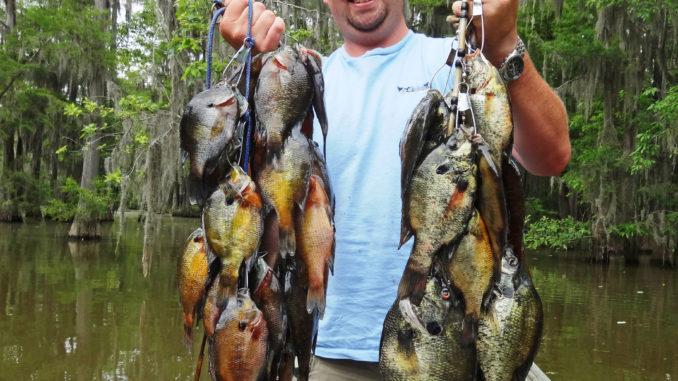
Cover plenty of water and you’ll run into concentrations of bream and fill your cooler
The bluegill and shellcracker action is red hot at Lake Marion and should stay that way through June. Limits can be caught whether the fish are bedding or not.
Matthew Outlaw of St. Matthews said June is great for consistent action of both species.
“Bream and shellcrackers will bed in June, but with the water warm, the fish are active anyway, so catching plenty of big fish not a problem,” he said. “Some think shellcracker fishing is over, but it’s not. Stay mobile, move and hunt the fish down. If you find them on the new or full moon bedding, it’s likely you’ll catch 25 or more from a spot. When they’re not bedding, you may catch 10 from a spot. You just hit more places and still end up with limits of big bream and shellcracker.”
Outlaw, 26, is already a veteran of the upper Lake Marion swamp where he often fishes, but he said the entire lake is productive.
“I love the swamp, been fishing there since I was in diapers,” he said, “but the technique is basically the same throughout the lake.”
“The fish will be cover-oriented, and I begin fishing around the 4-foot depth” he said. “Depending on water conditions I’ll go deeper and shallower until I find them, but that’s a good target depth to start. I use a 12-foot B‘n’M Double Duty rod because it’s got backbone for the huge shellcrackers but still great fun for bream. I don’t use a reel, I loop 8-pound Vicious line the length of the rod. I use a No. 4 Tru-Turn hook and a BB split-shot on the business end and a small float held with a toothpick so I can change depth as the water depth changes. I usually fish crickets but have redworms with me, and when I catch a shellcracker, I’ll often try worms to see if there’s more. Both baits will catch both species but worms are best to target shellcrackers.”
Outlaw said he will work trees, logs, stumps, weeds and most any cover he sees.
“Although I stay mobile I’ll give an area time to produce,’ he said. “I like small openings in dense clusters of trees, and I’ll work the edges and the scattered stumps and other cover, places many pass by. A small stump in the open can hold a pile of fish. If I catch a bunch in one area, I’ll return to that place later and often have an encore fish- catching experience. Whatever attracts fish to a specific place on that day will pull more fish if you let it rest and sneak back. Watch for a big mayfly hatch for excellent localized fishing.”
“Get the bait tight to cover,” he said. “With the cypress and gum trees, it’s easier for me to use the long pole. For shellcrackers, I like clusters of gum trees as well as cypress trees. For big bream, the isolated stumps are very good for bunches of fish, but the trees will hold lots of big bream. It’s simply a process of effectively fishing and moving to hit a hot spot. I always return to a productive place unless I get a limit too quick and have to go home and clean fish,” he said. “But that’s a problem I can live with.”





Be the first to comment